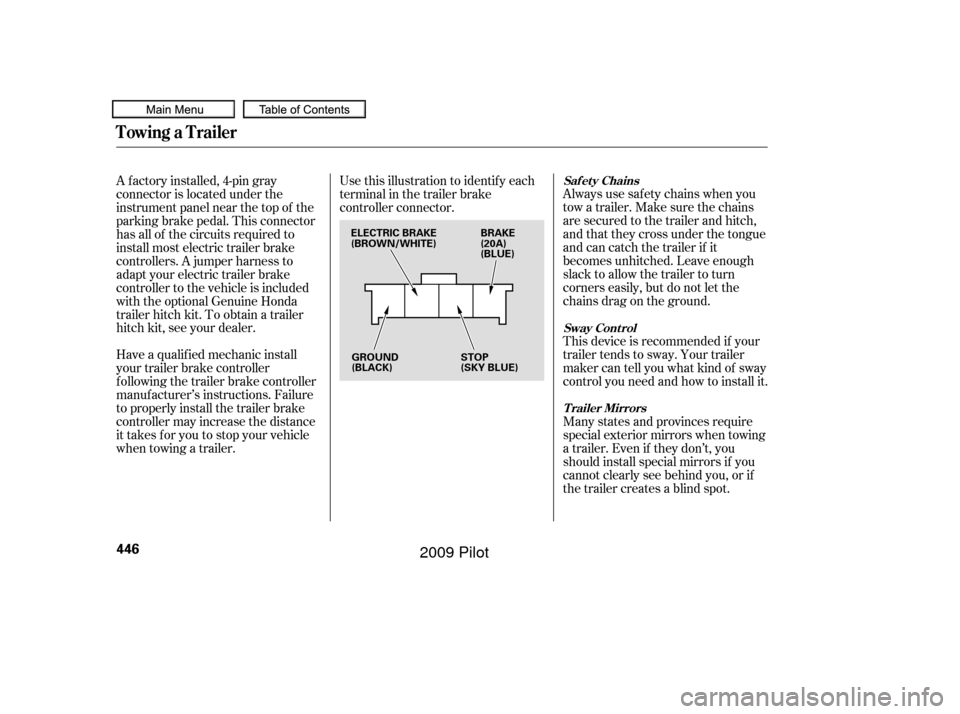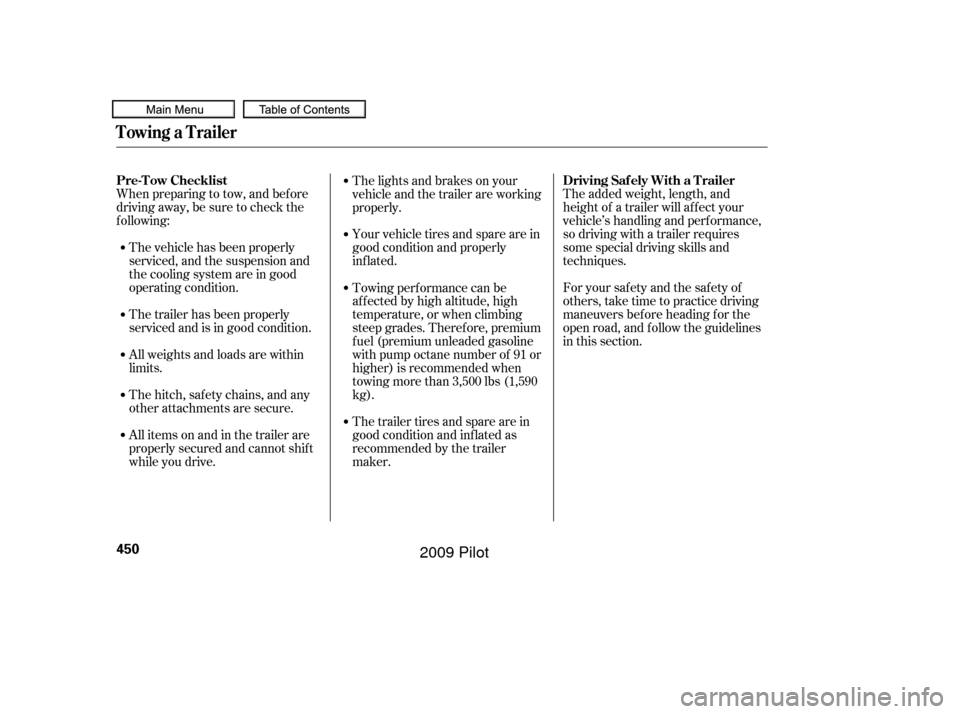Page 447 of 578
To accurately check your loads at
the public scale, the vehicle and
trailer should be f ully loaded, and all
occupants should stay in the vehicle
while the attendant watches the
scale.Check the f ront gross axle weight.
Limit: 2,921 lbs (1,325 kg) Check the gross vehicle weight.
Limit (4WD models): 6,096 lbs
(2,765 kg)
Limit (2WD models): 5,952 lbs
(2,700 kg)If you cannot weigh the rear axle
directly, you can calculate the rear
gross axle weight by subtracting
the weight in step 1 from the
weight in step 2.
Limit (4WD models): 3,175 lbs
(1,440 kg)
Limit (2WD models): 3,031 lbs
(1,375 kg)
Check the rear gross axle weight.
Limit (4WD models): 3,362 lbs
(1,525 kg)
Limit (2WD models): 3,196 lbs
(1,450 kg)
1. 2.
3.4.
CONT INUED
Checking L oads
Towing a Trailer
Driving
443
�����—�����—�
���y�
�������������y���
�(�/���������y���������y
2009 Pilot
Page 448 of 578
Calculate the tongue load.
Subtract the weight in step 6 f rom
the weight in step 7.
Limit: See page .
Recommended: see page .
Range: 5-10% f or boat trailers8-15% f or other trailers
Check the weight of the unhitched
trailer. Limit: See page .
Check the weight of the hitched
trailer. Write this number down.
Check the gross combined weight.
Limit (4WD models): 9,579 lbs
(4,345 kg)
Limit (2WD models): 8,466 lbs
(3,840 kg)
Remember, maximum gross
combined weight should be
decreased 2 % f or every 1,000 f eet
(305 meters) of elevation. 7.
8.
6.
5.
442
442 439
Towing a Trailer
444
�����—�����—�
���y�
�����������
�y���
�(�/���������y���������y
2009 Pilot
Page 449 of 578

CONT INUED
There are two common types of
trailer brakes: surge and electric.
Surge brakes are common f or boat
trailers, since the brakes will get wet.
If you choose electric brakes, be
sure they are electronically actuated.
Do not attempt to tap into your
vehicle’s hydraulic system. No
matter how successf ul it may seem,
any attempt to attach trailer brakes
to your vehicle’s hydraulic system
will lower braking ef f ectiveness and
create a potential hazard.
Read the trailer manufacturer’s
instructions, and select the
appropriate draw bar f or the height
of the trailer you will be towing.
A weight distributing hitch is not
recommended f or use with your
vehicle, as an improperly adjusted
weight distributing hitch may reduce
handling, stability, and braking
perf ormance.
Towing generally requires a variety
of supplemental equipment. To
ensure the best quality, we
recommend that you purchase
Honda equipment whenever possible.
Your dealer of f ers trailer packages
that include a ball mount, hitch plug,
and hitch pin. A wiring harness kit is
also available from your dealer.
Discuss any additional needs with
your trailer sales or rental agency,
and make sure all equipment is
properly installed, maintained, and
also meets state, f ederal, province,
and local regulations. Honda recommends that any trailer
with a total trailer weight of 1,000 lbs
(450 kg) or more has its own brakes.
Seeyourtrailerdealerorrental
agency f or more inf ormation on
installing electric brakes.
Towing a Trailer
Trailer Brakes
Hitch
Weight Distributing HitchT owing Equipment and
A ccessories
Driving
445
�����—�����—�
���y�
�������������y���
�(�/���������y���������y
2009 Pilot
Page 450 of 578

Always use saf ety chains when you
tow a trailer. Make sure the chains
are secured to the trailer and hitch,
and that they cross under the tongue
and can catch the trailer if it
becomes unhitched. Leave enough
slack to allow the trailer to turn
corners easily, but do not let the
chains drag on the ground.
This device is recommended if your
trailer tends to sway. Your trailer
maker can tell you what kind of sway
control you need and how to install it.
Many states and provinces require
special exterior mirrors when towing
a trailer. Even if they don’t, you
should install special mirrors if you
cannot clearly see behind you, or if
the trailer creates a blind spot.
Use this illustration to identif y each
terminal in the trailer brake
controller connector.
A f actory installed, 4-pin gray
connector is located under the
instrument panel near the top of the
parking brake pedal. This connector
has all of the circuits required to
install most electric trailer brake
controllers. A jumper harness to
adapt your electric trailer brake
controller to the vehicle is included
with the optional Genuine Honda
trailer hitch kit. To obtain a trailer
hitch kit, see your dealer.
Have a qualif ied mechanic install
your trailer brake controller
f ollowing the trailer brake controller
manuf acturer’s instructions. Failure
to properly install the trailer brake
controller may increase the distance
it takes f or you to stop your vehicle
when towing a trailer.
Towing a Trailer
Saf et y Chains
Sway Cont rolTrailer Mirrors
446
GROUND
(BLACK) BRAKE
(20A)
(BLUE)
ELECTRIC BRAKE
(BROWN/WHITE)
STOP
(SKY BLUE)
�����—�����—�
���y�
�������������y���
�(�/���������y�������
�y
2009 Pilot
Page 451 of 578

�´
Your vehicle is equipped with a
connector to install an optional trailer
lighting connector that mates with
your vehicle. You can get this
optional connector f rom your dealer.
Ref er to the above illustration f or
wiring information.
Trailer lights and equipment must
comply with f ederal, state, province,
and local regulations. Check trailer
light requirements f or the areas
where you plan to tow, and use only
equipment designed f or your vehicle.
When towing a trailer, we
recommend that you carry a f ull-size
spare wheel and tire for your vehicle
and trailer. When replacing the
compact spare with a f ull size spare,
remove the plastic spacer (see page
). Store the plastic spacer and
compact spare together. Reinstall
thespacerbeforeonceagainstowing
the compact spare.
See page f or proper tire size,
page f or how to store a f ull size
wheel and tire, and page for
inf ormation on changing a f lat tire.
Remember to unhitch the trailer
bef ore changing a f lat. Ask your
trailer sales or rental agency where
and how to store the trailer’s spare
tire. 505
506 513
519
CONT INUED
Towing a Trailer
Trailer LightsSpare Tires
Driving
447
GROUND
(BLACK)
LEFT TURN SIGNAL
AND BRAKE LIGHTS
(RED)
TAILLIGHTS
(GREEN)
RIGHT TURN SIGNAL
AND BRAKE LIGHTS
(WHITE)
ELECTRIC BRAKE
(BROWN/WHITE)
BACK-UP LIGHTS
(YELLOW)
GROUND
(BLACK)
B CHARGE
(BLUE)
�����—�����—�
���y�
�������������y���
�(�/���������y���������y
2009 Pilot
Page 452 of 578

The 7-pin trailer connector is needed
f or the trailer lights. To connect the
connector, do this:Make sure the connector and the
socketarefreeof dirt,moisture,
or other f oreign material.
Open the socket lid by pulling it up.
Your vehicle has a class 3 trailer
hitch as standard equipment.
We recommend that you have your
dealer install a Honda wiring harness
and converter. This harness has
been designed f or your vehicle.
If you use a non-Honda trailer
lighting harness and converter, you
can get the connector and pins that
mate with the connector in your
vehicle f rom your dealer.
Since lighting and wiring vary with
trailer type and brand, you should
also have a qualif ied mechanic install
a suitable connector between the
vehicleandthetrailer.
The jumper harness and trailer
brakefusearestoredintheglove
box.
Also see page f or trailer-related
inf ormation.1.
2.
445
On Touring models
Towing a Trailer
Connect ing t he T railer Connect orsTowing Equipment
448
TRAILER HITCH 7-PIN TRAILER CONNECTOR
LID
7-PIN TRAILER CONNECTOR SOCKET
RETAINING
TAB
RETAINING
TAB
7-PIN TRAILER
CONNECTOR
�����—�����—�
���y�
�������������y���
�(�/���������y���������y
2009 Pilot
Page 453 of 578
�´
Ref er to the above illustrations f or
wiring information.The trailer jumper harness is used to
install the controller f or the electric
trailer brakes. For more inf ormation,
see
on page .
Insert the connector securely into
the socket.
Hook the retaining tab on the
inner side of the lid against the
retaining tab of the connector to
prevent disconnection during
operation.
Insert the trailer brake f use into the
secondary under-hood f use box (see
page ).
3.
445
533
On Touring models On Touring models
Towing a Trailer
T railer Jumper Harness
T railer Connect or Socket s
Trailer Brakes
T railer Brake Fuse
Driving
449
7-PIN TRAILER SOCKET SMALL
LIGHT
(GREEN)
LEFT
TURN/
STOP
(RED)
BACK LIGHT
(YELLOW) GROUND
(BLACK)
BRAKE
(20A)
(BLUE)
ELECTRIC BRAKE
(BROWN/WHITE)
BRAKE LIGHTS
(SKY BLUE)
B
CHARGE
(BLUE)
RIGHT
TURN/
STOP
(WHITE)
ELECTRIC
BRAKE
(BROWN/
WHITE)
GROUND
(BLACK)
�����—�����—�
���y�
���������
���y���
�(�/���������y���������y
2009 Pilot
Page 454 of 578

When preparing to tow, and bef ore
driving away, be sure to check the
f ollowing:The added weight, length, and
height of a trailer will af f ect your
vehicle’s handling and perf ormance,
so driving with a trailer requires
some special driving skills and
techniques.
The vehicle has been properly
serviced, and the suspension and
the cooling system are in good
operating condition. The lights and brakes on your
vehicle and the trailer are working
properly.
Your vehicle tires and spare are in
good condition and properly
inf lated.
The trailer has been properly
serviced and is in good condition.
All weights and loads are within
limits.
Thehitch,safetychains,andany
other attachments are secure.
Allitemsonandinthetrailerare
properly secured and cannot shif t
while you drive. Foryoursafetyandthesafetyof
others,taketimetopracticedriving
maneuvers bef ore heading f or the
open road, and f ollow the guidelines
in this section.
Towing perf ormance can be
af f ected by high altitude, high
temperature, or when climbing
steep grades. Theref ore, premium
f uel (premium unleaded gasoline
with pump octane number of 91 or
higher) is recommended when
towing more than 3,500 lbs (1,590
kg).
The trailer tires and spare are in
good condition and inf lated as
recommended by the trailer
maker.
Towing a Trailer
Pre-T ow Checklist
Driving Saf ely With a T railer
450
�����—�����—�
���y�
�������������y���
�(�/���������y���������y
2009 Pilot